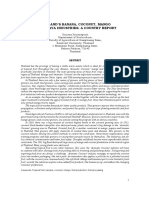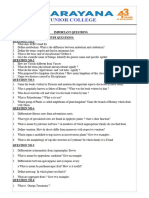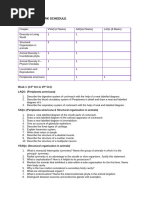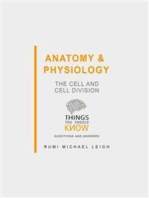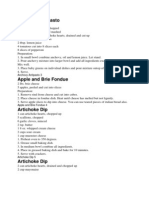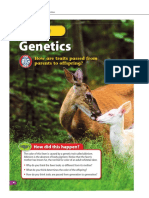0 ratings0% found this document useful (0 votes)
Cmda Bot 102 Test
Cmda Bot 102 Test
Uploaded by
Obinna AdolalomBryophytes are non-vascular plants that exhibit poikilohydrism and alternation of generations with rhizoids anchoring them. Angiosperms are seed plants that reproduce sexually through double fertilization forming seeds in an ovule. Plant tissues are classified into simple and complex tissues with parenchyma, collenchyma and sclerenchyma as the primary tissue types performing various functions.
Copyright:
© All Rights Reserved
Available Formats
Download as DOCX, PDF, TXT or read online from Scribd
Download as docx, pdf, or txt
Cmda Bot 102 Test
Cmda Bot 102 Test
Uploaded by
Obinna Adolalom0 ratings0% found this document useful (0 votes)
Bryophytes are non-vascular plants that exhibit poikilohydrism and alternation of generations with rhizoids anchoring them. Angiosperms are seed plants that reproduce sexually through double fertilization forming seeds in an ovule. Plant tissues are classified into simple and complex tissues with parenchyma, collenchyma and sclerenchyma as the primary tissue types performing various functions.
Original Description:
bot test
Copyright
© © All Rights Reserved
Available Formats
DOCX, PDF, TXT or read online from Scribd
Share this document
Did you find this document useful?
Is this content inappropriate?
Bryophytes are non-vascular plants that exhibit poikilohydrism and alternation of generations with rhizoids anchoring them. Angiosperms are seed plants that reproduce sexually through double fertilization forming seeds in an ovule. Plant tissues are classified into simple and complex tissues with parenchyma, collenchyma and sclerenchyma as the primary tissue types performing various functions.
Copyright:
© All Rights Reserved
Available Formats
Download as DOCX, PDF, TXT or read online from Scribd
Download as docx, pdf, or txt
0 ratings0% found this document useful (0 votes)
Cmda Bot 102 Test
Cmda Bot 102 Test
Uploaded by
Obinna AdolalomBryophytes are non-vascular plants that exhibit poikilohydrism and alternation of generations with rhizoids anchoring them. Angiosperms are seed plants that reproduce sexually through double fertilization forming seeds in an ovule. Plant tissues are classified into simple and complex tissues with parenchyma, collenchyma and sclerenchyma as the primary tissue types performing various functions.
Copyright:
© All Rights Reserved
Available Formats
Download as DOCX, PDF, TXT or read online from Scribd
Download as docx, pdf, or txt
You are on page 1/ 3
CMDA BOT MOCK 4.
The success of bryophytes is
TEST based on what?
5. Explain how bryophytes monitor
ALGAE AND LICHEN air pollution.
1. Mention four examples of 6. List the different stages present
freshwater habitats. in the haploid phase of the
2. Mention 5 criteria for classifying lifecycle of bryophytes in the
algae correct sequence.
3. Classify algae according to 7. Give one similarity and two
flagella and type of chlorophyll differences between rhizoids
present. and protonema.
4. What are the common names of 8. Give two examples of
the following algae: stegocarpous and
chlorophyta, phaeophyta, cleistocarpous mosses each.
bacillariophyta, rhodophyta, 9. Mention 4 uses of bryophytes.
xanthophyta and cyanophyta? 10.Give 2 examples each of leafy
5. Explain the process of sexual and thalloid-like liverworts.
reproduction in spirogyra. FLOWERS
6. One difference
between Anabaena and Oscillat 1. What are the two types of
oria is ___ inflorescences?
7. Why are diatoms resistant to 2. Mention the types of racemose
acid? and cymose inflorescences.
8. Differentiate between the two 3. What is racemose
types of diatoms. inflorescence?
9. Mention 4 uses of diatomites 4. What is a flower?
10.Give the photosynthetic 5. Mention the 4 whorls of a flower
products of each of the algae and give the individual parts for
listed in no. 5 above. each of them.
11.What are the functions of algae 6. Define the following terms:
and fungi in lichen? bract, bracteole, ebracteate,
12.Mention 3 types of lichens and pedicellate, subsessile and
give e.g of each of them. sessile.
13.Mention 4 uses of lichens. 7. Differentiate between staminate
14.Give the names of the two and pistillate flowers.
chemicals that make Cladonia 8. Explain the following terms:
unpalatable to man. monoecious, dioecious and
15.What element helps blue-green polygamous plants.
algae in fixing atmospheric
nitrogen. LEAF
BRYOPHYTES 1. Explain the two types of leaves
in terms of light illumination and
1. What is poikilohydrism? plants they are found in.
2. What is the function of the 2. Illustrate the distribution of
rhizoids of bryophytes? stomata in different parts of the
3. What is alternation of epidermis.
generation? 3. Mention two types of mesophyll.
4. A modification of the isolateral PLANT TISSUES
leaf is ___.
5. What is a compound leaf? 1. What is histology?
6. Mention the types of pinnate 2. Mention 5 ways of classifying
leaf. tissues.
7. Mention the parts that make up 3. Differentiate between simple
the vegetative parts of a plant. and complex tissues and give
8. What is a palmately compound examples of each.
leaf? 4. Why do parenchyma cells retain
9. Explain the types of palmately the ability to divide?
compound leaf. 5. Why are parenchyma tissues
10.List the different shapes of considered primitive both
leaves. phylogenetically and
11.Give the scientific names for the ontogenetically.
following: onion, potato and 6. Mention 6 parts of the plant that
bamboo. contain parenchyma.
12.Explain the different types of 7. Mention different shapes of
leaf apices. parenchyma and parts of the
13.List the types of leaf margins. plant they can be found in.
14.Give examples for each of the 8. Mention four functions of
types of palmately compound parenchyma cells.
leaf. 9. What does the presence of
living protoplast in collenchyma
PLANT CLASSIFICATION AND cells indicate?
EVOLUTION 10.Explain the different types of
collenchyma tissue.
1. Mention the orders under
11.What is sclerenchyma tissue?
Dicotyledonae. 12.What is collenchyma?
2. Define the following: 13.What are the types of
identification, classification and sclerenchyma cells?
systematics. 14.What is the basis of
3. Differentiate between artificial classification of the types of
classification and natural fibres and mention the types of
classification. fibres?
4. What is ICBN? 15.Give two economic importance
5. Mention five problems faced by
of fibres.
terrestial plants. 16.Mention six types of sclereids.
6. What are gametangia? 17.Explain the types of sclereids.
7. What are the four major periods 18.Define tracheary elements.
of plant evolution and the years 19.What is a xylem vessel?
in which they existed? 20.Explain the types of
8. Explain what happened in each perforations in xylem tissue.
of the periods of plant 21.List the main components of the
evolution. epidermis.
9. What are three similarities 22.Mention three types of
between terrestial plants and modifications of the epidermis.
green algae? 23.Give the other names for root
10.What is alternation of covering instead of epidermis.
generation?
PTERIDOPHYTES 11.What is the chromosome
number of the endosperm?
1. List all the cryptogamic plants 12.Explain the process of double
in the correct evolutionary fertilization in angiosperms.
order. 13.Give 4 common e.g of
2. What is the crozier or gymnosperms.
fiddlehead? 14.What are the economic
3. Why are the crozier not usually importance of gymnosperms
consumed even though they are (4)?
succulent and edible? 15.Explain the process of cell
4. Mention 3 examples of ferns. division in the female
5. What are sterile and fertile
gymnosperm.
fronds?
6. Give specific e.g of STEM AND ROOTS
pteridophytes and places they
grow. 1. What are the functions of the
7. Mention 3 economic importance stem?
of pteridophytes. 2. List the regions seen from the
8. Mention 5 chemicals used for transverse section of the stem.
phytochemical screening. 3. Mention 3 layers of the cortex.
9. What is the name of the plant 4. What is the pericycle in a dicot
from which cocaine is stem?
5. What is the stele?
extracted?
6. The vascular bundles of dicot
10.Give one difference between
stems are separated from each
Selaginella and other ferns.
other by ___
SPERMATOPHYTA 7. What are the components of
each vascular bundle in the
1. The two groups that produce dicot stem?
seeds are ___ and ___ 8. List the organs seen in the
2. What is inflorescence? transverse section of the root.
3. What is the function of the 9. What is the piliferous layer?
synergids in the female 10.Mention the components of the
gametophyte? xylem.
4. Give one difference between 11.Classify plants according to the
sepals and petals. presence or absence of stems.
5. Define corolla and calyx. 12.Mention the general types of
6. Explain the process of stems.
microsporogenesis in 13.Explain the 5 types of sub-aerial
angiosperms and stems and give examples for
gymnosperms. each of them.
7. List the different parts of a 14.Explain the types of sub-
pollen grain. terranean stems and give
8. What is an ovule? examples for each of them.
9. Give the names of each of the 8 15.What is phylloclade?
nuclei formed after mitosis in
the megaspore.
10.What is the purpose of meiosis
in plants?
You might also like
- BT I 2018 Revision Question Bank Class Xi: Living World and Biological ClassificationNo ratings yetBT I 2018 Revision Question Bank Class Xi: Living World and Biological Classification8 pages
- Xi. Biology. Revision Work.-Ch.3,4,&5. 3. Plant Kingdom. 1.what Do You Mean by ? 3.why Is Algae Grouped Under Thllophyta? 4. Write TheNo ratings yetXi. Biology. Revision Work.-Ch.3,4,&5. 3. Plant Kingdom. 1.what Do You Mean by ? 3.why Is Algae Grouped Under Thllophyta? 4. Write The2 pages
- 1st Year Biology Important Short &long QuestionsNo ratings yet1st Year Biology Important Short &long Questions4 pages
- AP Bio Chapter Objectives - 29, 30, 35 - 38No ratings yetAP Bio Chapter Objectives - 29, 30, 35 - 387 pages
- 11th STD BIO-BOTANY Revised English Medium Book Back Ans100% (2)11th STD BIO-BOTANY Revised English Medium Book Back Ans51 pages
- Morphology of Flowering Plants AssignmentNo ratings yetMorphology of Flowering Plants Assignment1 page
- Amoeba Sisters_ Plants-Diversity, Structure & Adaptations VideoNo ratings yetAmoeba Sisters_ Plants-Diversity, Structure & Adaptations Video8 pages
- Question Bank, 11th Botany (Dr. Shabir Hussain)No ratings yetQuestion Bank, 11th Botany (Dr. Shabir Hussain)2 pages
- Class 11 Biology Botany em Revised Edition-2020 English Medium Book Back Answers C.kishore KumarNo ratings yetClass 11 Biology Botany em Revised Edition-2020 English Medium Book Back Answers C.kishore Kumar51 pages
- Namma Kalvi 11th Bio-Botany Study Material English Medium 219431100% (4)Namma Kalvi 11th Bio-Botany Study Material English Medium 21943151 pages
- XI Botany Chapterwise Prvs Questions Hsslive PDFNo ratings yetXI Botany Chapterwise Prvs Questions Hsslive PDF25 pages
- Important Questions For CBSE Class 11 Biology Chapter 3No ratings yetImportant Questions For CBSE Class 11 Biology Chapter 320 pages
- 12th Bio Botany Important Questions English MediumNo ratings yet12th Bio Botany Important Questions English Medium7 pages
- 12-BIOLOGY QUESTION BANK (With Value Based Questions) - 1No ratings yet12-BIOLOGY QUESTION BANK (With Value Based Questions) - 133 pages
- Anatomy and Physiology: The Cell and Cell Division: Things You Should Know (Questions and Answers)From EverandAnatomy and Physiology: The Cell and Cell Division: Things You Should Know (Questions and Answers)No ratings yet
- Read The Short Story Below and Answer The Questions That FollowNo ratings yetRead The Short Story Below and Answer The Questions That Follow13 pages
- Application of Nuclear Techniques in Food and AgricultureNo ratings yetApplication of Nuclear Techniques in Food and Agriculture35 pages
- New Pharma Citrus Limonum Monograph Eng 0507No ratings yetNew Pharma Citrus Limonum Monograph Eng 05074 pages
- AppetitePaper PaperFlowerGuide SurnriseWildflower100% (1)AppetitePaper PaperFlowerGuide SurnriseWildflower10 pages
- Heredity: Presented By: Pauline Grace P. CastillanoNo ratings yetHeredity: Presented By: Pauline Grace P. Castillano22 pages
- The Evolutionary History of Fouquieriaceae (Ericales) : Biogeography, Growth Habit, Habitat Colonization, and Chromosome EvolutionNo ratings yetThe Evolutionary History of Fouquieriaceae (Ericales) : Biogeography, Growth Habit, Habitat Colonization, and Chromosome Evolution11 pages
- Jurnal Pengaruh Induksi Fungi Mikoriza Arbuskula (Fma) TerhadapNo ratings yetJurnal Pengaruh Induksi Fungi Mikoriza Arbuskula (Fma) Terhadap8 pages
- Genetics: How Are Traits Passed From Parents To Offspring?No ratings yetGenetics: How Are Traits Passed From Parents To Offspring?40 pages


